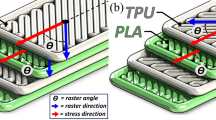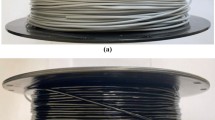Abstract
Currently, multi-material approach has become an interesting research subject in the field of materials engineering and additive manufacturing technology. With this technique, the properties of a 3D-printed material could be tailored by combining two or more dissimilar materials with certain configurations such as the sandwich structures. So far, the studies concerning such sandwich-structured FFF multi-material system is, however, still lacking. In this research, mechanical properties of the sandwich-structured FFF-processed multi-material parts composed of a rigid polylactic acid (PLA) and a flexible thermoplastic polyurethane (TPU) were determined. Three groups of specimens with various sandwich configurations were examined in terms of their maximum tensile strength, strain at break and elastic modulus. In addition, a Shore D hardness analysis was carried out to point out the benefits of having the multi-material structure in the FFF-processed polymeric material. The result of this study showed that the combination of PLA/TPU in a sandwich form could improve the low strength and elastic modulus of an FFF-processed monolithic TPU elastomer. In this case, the tensile strength and elastic modulus of the sandwich-structured PLA/TPU multi-material were higher than those of the printed monolithic TPU. However, this strategy was not successful for improving the low strain-at-break possessed by the FFF printed monolithic PLA material. On the basis of the analysis over the fractured surface of the specimen, the low affinity and low compatibility between the deposited PLA and TPU material obviously caused the failure of this sandwich-structured FFF-processed PLA/TPU multi-material.








Similar content being viewed by others
References
Dizon JRC, Espera AH, Chen Q, Advincula RC (2018) Mechanical characterization of 3D-printed polymers. Addit Manuf 20:44–67. https://doi.org/10.1016/j.addma.2017.12.002
Vyavahare S, Teraiya S, Panghal D, Kumar S (2020) Fused deposition modelling: a review. Rapid Prototyp J 26:176–201. https://doi.org/10.1108/RPJ-04-2019-0106
Lee Ventola C (2014) Medical applications for 3D printing: current and projected uses. Pharm Therapeutic 39:704–711. https://www.ncbi.nlm.nih.gov/pmc/articles/PMC4189697
Tan LJ, Zhu W, Zhou K (2020) Recent progress on polymer materials for additive manufacturing. Adv Funct Mater 30:2003062. https://doi.org/10.1002/adfm.202003062
Sathies T, Senthil P, Anoop MS (2020) A review on advancements in applications of fused deposition modelling process. Rapid Prototyp J 26:669–687. https://doi.org/10.1108/RPJ-08-2018-0199
Uriondo A, Esperon-Miguez M, Perinpanayagam S (2015) The present and future of additive manufacturing in the aerospace sector: a review of important aspects. Proc Inst Mech Eng Part G J Aerosp Eng 229:2132–2147. https://doi.org/10.1177/0954410014568797
Colorado HA, Mendoza DE, Valencia FL (2021) A combined strategy of additive manufacturing to support multidisciplinary education in arts, biology, and engineering. J Sci Educ Technol 30:58–73. https://doi.org/10.1007/s10956-020-09873-1
Sood AK, Ohdar RK, Mahapatra SS (2012) Experimental investigation and empirical modelling of FDM process for compressive strength improvement. J Adv Res 3:81–90. https://doi.org/10.1016/j.jare.2011.05.001
Han D, Lee H (2020) Recent advances in multi-material additive manufacturing: methods and applications. Curr Opin Chem Eng 28:158–166. https://doi.org/10.1016/j.coche.2020.03.004
Baca D, Ahmad R (2020) The impact on the mechanical properties of multi-material polymers fabricated with a single mixing nozzle and multi-nozzle systems via fused deposition modeling. Int J Adv Manuf Technol 106:4509–4520. https://doi.org/10.1007/s00170-020-04937-3
Espalin D, Ramirez JA, Medina F, Wicker R (2014) Multi-material, multi-technology FDM: exploring build process variations. Rapid Prototyp J 20:236–244. https://doi.org/10.1108/RPJ-12-2012-0112
Ruiz OG, Dhaher Y (2021) Multi-color and multi-material 3D printing of knee joint models. 3D Print Med 7:1–16. https://doi.org/10.1186/s41205-021-00100-0
Lopes LR, Silva AF, Carneiro OS (2018) Multi-material 3D printing: the relevance of materials affinity on the boundary interface performance. Addit Manuf 23:45–52. https://doi.org/10.1016/j.addma.2018.06.027
Bandyopadhyay A, Heer B (2018) Additive manufacturing of multi-material structures. Mater Sci Eng R Rep 129:1–16. https://doi.org/10.1016/j.mser.2018.04.001
Tamburrino F, Graziosi S, Bordegoni M (2019) The influence of slicing parameters on the multi-material adhesion mechanisms of FDM printed parts: an exploratory study. Virtual Phys Prototyp 14:316–332. https://doi.org/10.1080/17452759.2019.1607758
Zhang YF, Ng CJ, Chen Z, Zhang W, Panjwani S, Kowsari K, Yang HY, Ge Q (2019) Miniature pneumatic actuators for soft robots by high-resolution multimaterial 3D printing. Adv Mater Technol 4:1900427. https://doi.org/10.1002/admt.201900427
Emon MOF, Alkadi F, Philip DG, Kim DH, Lee KC, Choi JW (2019) Multi-material 3D printing of a soft pressure sensor. Addit Manuf 28:629–638. https://doi.org/10.1016/j.addma.2019.06.001
Coelho G, Chaves TMF, Goes AF, Del Massa EC, Morses O, Yoshida M (2018) Multimaterial 3D printing preoperative planning for frontoethmoidal meningoencephalocele surgery. Childs Nerv Syst 34:749–756. https://doi.org/10.1007/s00381-017-3616-6
Arifvianto B, Wirawan YB, Salim UA, Suyitno S, Mahardika M (2021) Effects of extruder temperatures and raster orientations on mechanical properties of the FFF-processed polylactic-acid (PLA) material. Rapid Prototyp J 27:1761–1775. https://doi.org/10.1108/rpj-10-2019-0270
Arifvianto B, Iman TN, Prayoga BT, Dharmastiti R, Salim UA, Mahardika M, Suyitno, (2021) Tensile properties of the FFF-processed thermoplastic polyurethane (TPU) elastomer. Int J Adv Manuf Technol 117:1709–1719. https://doi.org/10.1007/s00170-021-07712-0
Xiao J, Gao Y (2017) The manufacture of 3D printing of medical grade TPU. Prog Addit Manuf 2:117–123. https://doi.org/10.1007/s40964-017-0023-1
Ribeiro M, Sousa Carneiro O, Ferreira da Silva A (2019) Interface geometries in 3D multi-material prints by fused filament fabrication. Rapid Prototyp J 25:38–46. https://doi.org/10.1108/RPJ-05-2017-0107
Luna CBB, Siqueira DD, Araujo EM, Wellen RMR (2021) Annealing efficacy on PLA. Insights on mechanical, thermomechanical and crystallinity characters. Momento 62:1–17. https://doi.org/10.15446/mo.n62.89099
Banoriya D, Purohit R, Dwivedi RK (2020) Wear performance of titanium reinforced biocompatible TPU. Adv Mater Process Technol 6:284–291. https://doi.org/10.1080/2374068X.2020.1731232
Brancewicz-steinmetz E, Sawicki J, Byczkowska P (2021) The influence of 3D printing parameters on adhesion between polylactic acid (PLA) and thermoplastic polyurethane (TPU). Materials 14:6464. https://doi.org/10.3390/ma14216464
Freund R, Watschke H, Heubach J, Vietor T (2019) Determination of influencing factors on interface strength of additively manufactured multi-material parts by material extrusion. Appl Sci 9:1782. https://doi.org/10.3390/app9091782
Lopez DMB, Ahmad R (2020) Tensile mechanical behaviour of multi-polymer sandwich structures via fused deposition modelling. Polymers 12:651. https://doi.org/10.3390/polym12030651
Singh R, Kumar R, Farina I, Colangelo F, Feo L, Fraternali F (2019) Multi-material additive manufacturing of sustainable innovative materials and structures. Polymers 11:62. https://doi.org/10.3390/polym11010062
Yin J, Lu C, Fu J, Huang Y, Zheng Y (2018) Interfacial bonding during multi-material fused deposition modeling (FDM) process due to inter-molecular diffusion. Mater Des 150:104–112. https://doi.org/10.1016/j.matdes.2018.04.029
Author information
Authors and Affiliations
Corresponding author
Additional information
Publisher's Note
Springer Nature remains neutral with regard to jurisdictional claims in published maps and institutional affiliations.
Rights and permissions
About this article
Cite this article
Arifvianto, B., Satiti, B.E., Salim, U.A. et al. Mechanical properties of the FFF sandwich-structured parts made of PLA/TPU multi-material. Prog Addit Manuf 7, 1213–1223 (2022). https://doi.org/10.1007/s40964-022-00295-6
Received:
Accepted:
Published:
Issue Date:
DOI: https://doi.org/10.1007/s40964-022-00295-6




